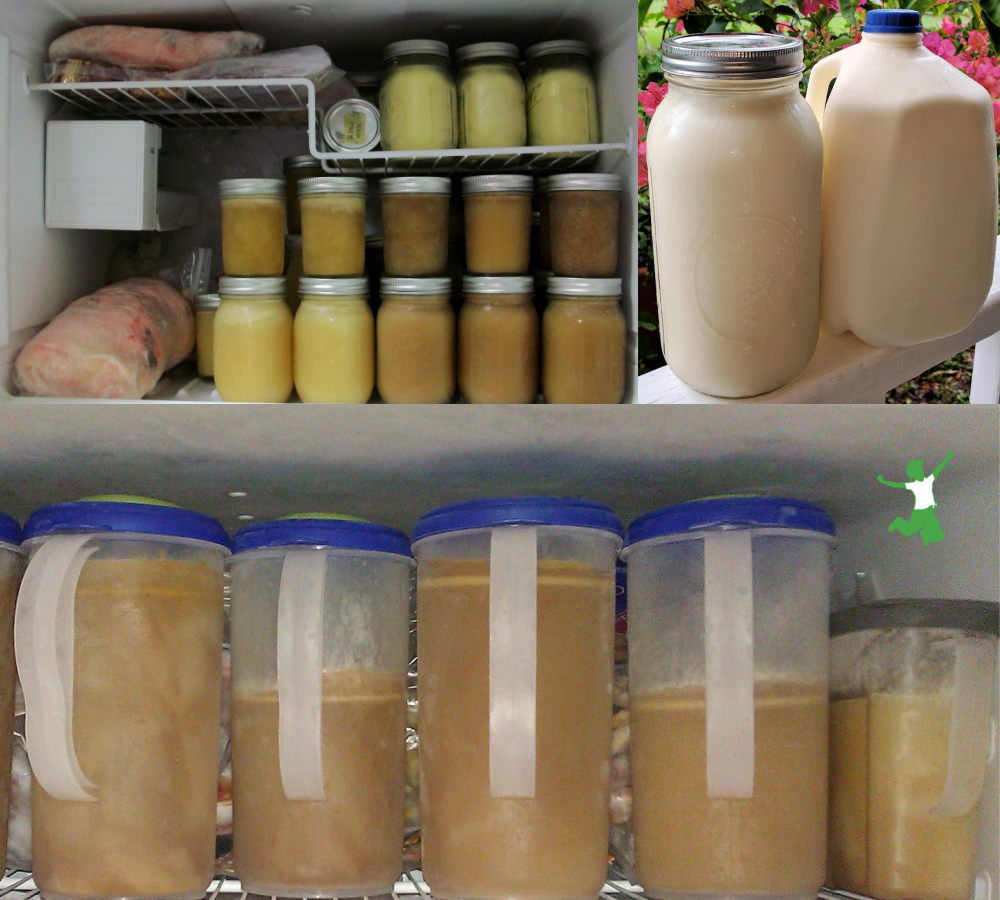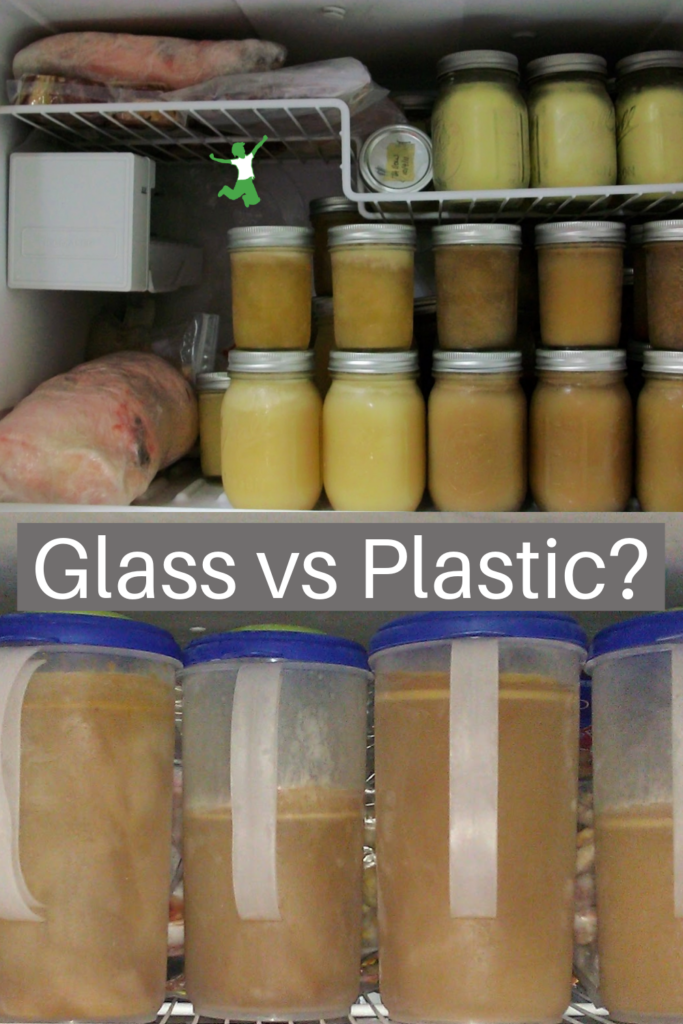Choosing and using the best freezer containers that will keep your food optimally fresh and avoid issues with cracking, leaching, or breakage.

When it comes to freezing raw milk and other traditional foods like bone broth, there are so many types of containers to choose from!
There are certainly pros and cons for both glass and plastic if you examine the issue from both a practical and environmentally-friendly standpoint.
While glass may be the obvious green choice, is it safe to use for freezing especially with young children in the house?
Are the leaching concerns regarding plastic overblown when it comes to frozen foods?
Let’s take a look and see!
Plastic Freezer Containers
The good news is that if you’ve been using plastic for frozen food storage, the practice is probably not leaching chemicals as long as the food is room temperature or colder when it is put in the container.
Cold plastic does not leach chemicals at a rapid rate like heated plastic does.
So, while you should never put hot food or liquids into contact with plastic, storing cold or frozen food is usually safe with high-quality containers (never single-use, old, or scratched plastic).
Caveats to this practice include avoiding storage of acidic liquids (like apple cider vinegar) and foods (tomato sauce) in plastic.
In addition, fatty and oily foods tend to be more prone to sucking chemicals out of plastic compared to dry foods like nuts or flour. (1)
Another downside to plastic versus glass is that the food generally has more issues with freezer burn over time.
Tips for Safe Plastic Use in the Freezer
Here are some other tips from the Environmental Working Group (EWG) for the safe use of plastic for food storage and as freezer containers: (2)
- Don’t microwave food or drinks in plastic containers — even if they claim to be “microwave safe.” Heat can break down plastics and release chemical additives into your food and drink. In addition, microwaves heat unevenly, creating hot spots where the plastic is more likely to get too hot, break down, and release chemicals.
- Use plastic containers for cool or frozen liquids and food only — never hot.
- Don’t reuse single-use plastics. They can break down and release hormone-disrupting chemicals when used repeatedly.
- Avoid old, scratched plastic containers. Exposures to the chemicals in plastic may be greater when the surface is worn down.
- Wash plastic containers by hand with mild dishsoap and only using warm (never hot) water. Keep plastic out of the dishwasher!
If you follow these guidelines for using plastic for freezing, it is a relief to know you are most likely not exposing yourself and your family to hormone-disrupting or forever chemicals.
However, plastic is clearly not as green a choice environmentally speaking as glass for freezer containers.
If you would prefer to up your game with regard to freezer containers and transition to glass, you will be happy to learn that it is possible to use this type of container safely!
As a bonus, you will find that food stored in glass tastes better when it is thawed and used in your favorite recipes!
Using Glass
The key to safe usage of glass for freezing raw dairy and other foods is choosing the right type and size of jars.
Take heart if you’ve had a lot of breakage when attempting to freeze food in glass before. There are several tricks to know about that avoid these problems!
Two things in particular impact the chance of breakage when using a particular glass jar as a freezer container:
- Age
- Shape
Old glass jars will break much more readily than new ones.
Make sure that the glass containers you select for freezing are new or relatively so.
It’s also a good idea to put a plan in place to replace them every so often to avoid breakage.
My rule of thumb is to not use any jars older than a year for the freezer. I use older jars for pantry storage instead.
Jar Shape is Crucial
While the age of the container is important, the shape of the glass container is critical.
Be sure that the glass jars you choose as freezer containers are straight-sided if at all possible.
This is because if there is any narrowing of the container toward the top, the container is more likely to crack during the freezing process.
If you remember from high school chemistry, as liquids containing water freeze, they expand upwards.
This is what gives rise to the tendency of glass to crack if that expansion process is restricted in any way by the container’s shape.
If there is no narrowing of the container during this upward expansion, problems and cracking/breakage are unlikely.
What if a jar curves only at the bottom?
No worries there. The narrowing and curving toward the top of the jar is what matters most when it comes to avoiding breakage.
What If All your Jars Narrow At the Top?
If you have curved jars that narrow toward the top, there is no need to replace them if you want to use them as freezer containers.
Simply leave enough room for expansion so that the frozen liquid won’t go above the narrowed portion of the jar.
Leave the Lid Off Until the Food is Frozen
It is common sense not to fill a glass container to the top with liquid if you intend to freeze it.
Even if a straight-sided jar is used in that case, it will still crack when the expanding liquid encounters a lid.
If you wish to be extra safe to ensure no cracking of a glass jar, I suggest leaving the lid off entirely until the liquid has completely frozen.
Then, gently screw on the lid…but never too tightly.
Waiting until the food/liquid inside the jar is frozen before putting on the lid.
This trick will also extend the life of the jar for freezing purposes.
Safest Method for Freezing Food in Glass
If freezing in glass still makes you nervous even after reviewing the guidelines above, it would be best to stick with commercial canning jars that are labeled as freezer-safe.
Freezer-safe jars (such as these) are not only straight-sided but also have a handy fill line marked right on the jar.
This way, you know exactly how much food or liquid to put in to prevent cracking or breakage.
Buying canning jars labeled as freezer-safe with a maximum fill line etched right on the glass takes all the guesswork out of the process.
These containers permit the use of glass…the greenest and healthiest material for freezer containers – to be used without worry.
BPA-Free Lids
I have one more tip to pass along when choosing and using glass for freezer containers.
Be sure to use jars that come with BPA-free lids.
Metal, screw-on lids that have white plastic on the underside of the lid are not preferable to metal lids that are plain metal on the underside.
Alternatively, you can choose BPA-free plastic lids (such as these) for your glass jars.
In my opinion, however, the plain metal screw-on lids are better because they don’t use any plastic at all.
Do you have any other tips for safe, green freezer containers?
Please share with all of us in the comments section.

(1) Nearly 10,000 chemicals leaching from plastic containers into food, alarming study reveals
(2) Pick Plastics Carefully








Leave a Reply